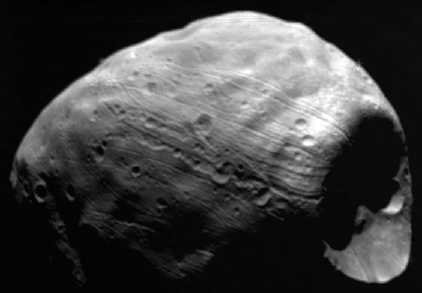Phobos 火卫一(英)
(单词翻译:单击)

Phobos (FOH bus) is the larger and innermost of Mars' two moons. Phobos is closer to its primary than any other moon in the solar system, less than 6000 km above the surface of Mars. It is also one of the smallest moons in the solar system.
orbit: 9378 km from the center of Mars
diameter: 22.2 km (27 x 21.6 x 18.8)
mass: 1.08e16 kg
In Greek mythology1, Phobos is one of the sons of Ares (Mars) and Aphrodite (Venus). phobos is Greek for fear (the root of phobia).
Discovered 1877 August 18 by Hall; photographed by Mariner2 9 in 1971, Viking 1 in 1977, and Phobos in 1988.
Phobos orbits Mars below the synchronous3 orbit radius4. Thus it rises in the west, moves very rapidly across the sky and sets in the east, usually twice a day. It is so close to the surface that it cannot be seen above the horizon from all points on the surface of Mars.
And Phobos is doomed5: because its orbit is below synchronous altitude tidal forces are lowering its orbit (current rate: about 1.8 meters per century). In about 50 million years it will either crash onto the surface of Mars or (more likely) break up into a ring. (This is the opposite effect to that operating to raise the orbit of the Moon.)
Phobos and Deimos may be composed of carbon-rich rock like C-type asteroids7. But their densities8 are so low that they cannot be pure rock. They are more likely composed of a mixture of rock and ice. Both are heavily cratered10. New images from Mars Global Surveyor indicate that Phobos is covered with a layer of fine dust about a meter thick, similar to the regolith on the Earth's Moon.
The Soviet11 spacecraft Phobos 2 detected a faint but steady outgassing from Phobos. Unfortunately, Phobos 2 died before it could determine the nature of the material; water is the best bet. Phobos 2 also returned a few images (right).
The most prominent feature on Phobos is the large crater9 named Stickney, the maiden12 name of Hall's wife (above). Like Mimas' crater Herschel (on a smaller scale) the impact that created Stickney must have almost shattered Phobos. The grooves13 and streaks14 on the surface were probably also caused by the Stickney impact.
Phobos and Deimos are widely believed to be captured asteroids. There is some speculation15 that they originated in the outer solar system rather than in the main asteroid6 belt.
Phobos and Deimos may someday be useful as space stations from which to study Mars or as intermediate stops to and from the Martian surface; especially if the presence of ice is confirmed.
 收听单词发音
收听单词发音
1
mythology

|
|
| n.神话,神话学,神话集 | |
参考例句: |
|
|
|
2
mariner

|
|
| n.水手号不载人航天探测器,海员,航海者 | |
参考例句: |
|
|
|
3
synchronous

|
|
| adj.同步的 | |
参考例句: |
|
|
|
4
radius

|
|
| n.半径,半径范围;有效航程,范围,界限 | |
参考例句: |
|
|
|
5
doomed

|
|
| 命定的 | |
参考例句: |
|
|
|
6
asteroid

|
|
| n.小行星;海盘车(动物) | |
参考例句: |
|
|
|
7
asteroids

|
|
| n.小行星( asteroid的名词复数 );海盘车,海星 | |
参考例句: |
|
|
|
8
densities

|
|
| 密集( density的名词复数 ); 稠密; 密度(固体、液体或气体单位体积的质量); 密度(磁盘存贮数据的可用空间) | |
参考例句: |
|
|
|
9
crater

|
|
| n.火山口,弹坑 | |
参考例句: |
|
|
|
10
cratered

|
|
| adj.有坑洞的,多坑的v.火山口( crater的过去分词 );弹坑等 | |
参考例句: |
|
|
|
11
Soviet

|
|
| adj.苏联的,苏维埃的;n.苏维埃 | |
参考例句: |
|
|
|
12
maiden

|
|
| n.少女,处女;adj.未婚的,纯洁的,无经验的 | |
参考例句: |
|
|
|
13
grooves

|
|
| n.沟( groove的名词复数 );槽;老一套;(某种)音乐节奏v.沟( groove的第三人称单数 );槽;老一套;(某种)音乐节奏 | |
参考例句: |
|
|
|
14
streaks

|
|
| n.(与周围有所不同的)条纹( streak的名词复数 );(通常指不好的)特征(倾向);(不断经历成功或失败的)一段时期v.快速移动( streak的第三人称单数 );使布满条纹 | |
参考例句: |
|
|
|
15
speculation

|
|
| n.思索,沉思;猜测;投机 | |
参考例句: |
|
|
|
- 上一篇:Mars 火星(英)
- 下一篇:Deimos 火卫二(中英对照)




